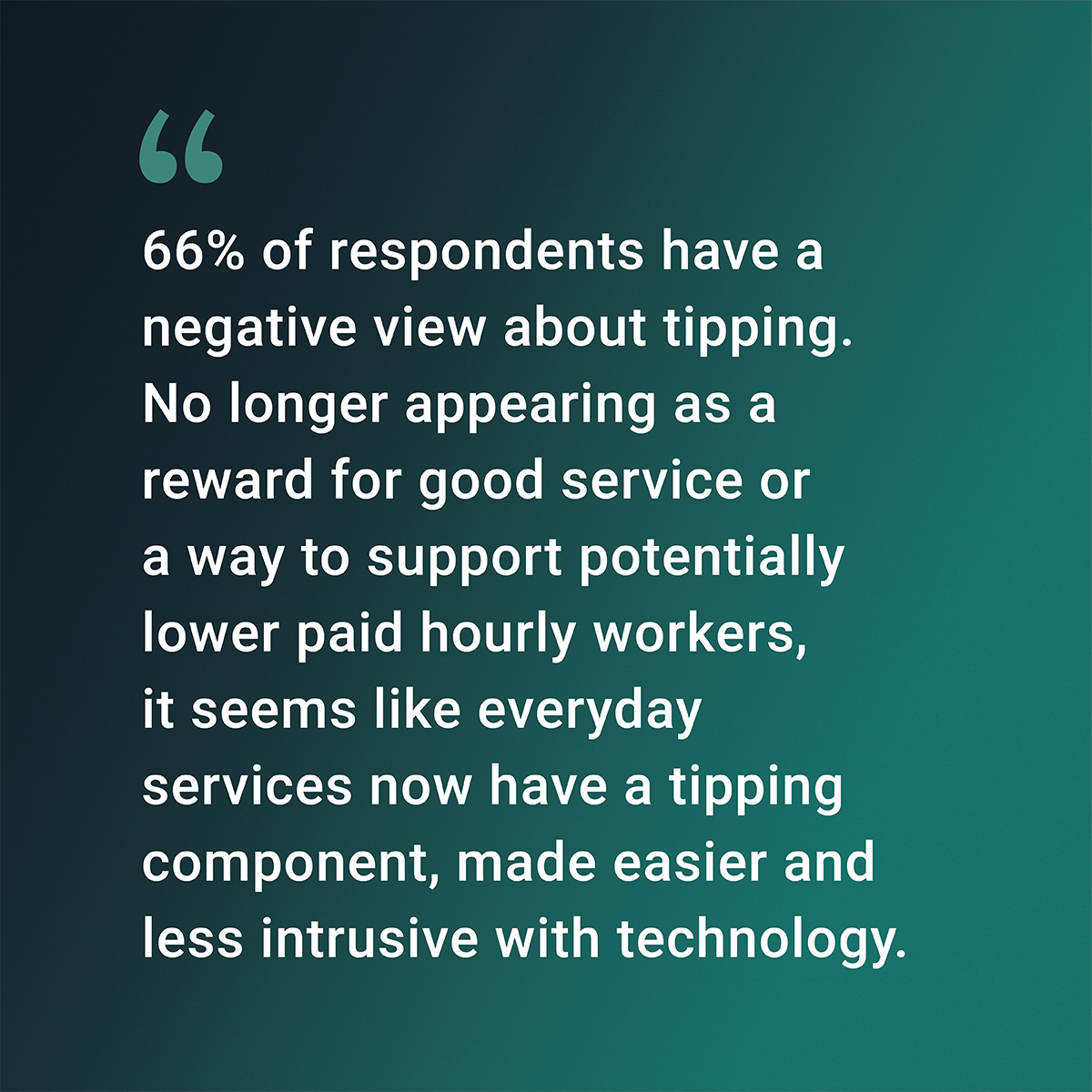During the pandemic, finding people willing to work in restaurants was difficult. There were safety risks, uncertain hours of operation, and an escalation of establishments permanently shuttered. Those who showed up and worked hard were met by customers with grateful smiles, heartfelt thank you, and generous tips. Although not equal to the heroic work of the health worker, for whom we banged pots and pans every night, this group was elevated alongside other professions during the pandemic.
Although we are no longer banging pots and pans, the elevated tipping that became customary during this period has not gone away. Combined with extreme food cost increases, tipping 18% is more expensive now than it was for the same meal just a few years ago. In addition, there is frequently a “Lettuce Entertain You 3%” service charge added, and in San Francisco, many have started seeing a “Health San Francisco Surcharge” allowing restauranteurs help in paying for employee health insurance.
Has the American Consumer Hit Peak Tipping?
Tipping practices in the United States are deeply ingrained in the service industry, specifically customary in restaurants, bars, hotels, taxis and ride shares, hair salons, coffee shops, food and grocery delivery, and other service-oriented establishments. This is often seen to reward good service, but more and more it seems like the customer is being asked to supplement the employers’ payroll.
And while it is important to note that tipping practices can vary between different regions and establishments within the United States, the historical “15%-18% tip” or “double the tax” seems to have gone by the wayside.
Not too long ago, it appeared that the industry was making inroads into a non-tipping culture.
But then the restaurant world as we know it changed due to COVID-19. Restaurants closed. Staff moved. Raw goods costs increased. Labor costs increased. Home delivery of prepared foods (and groceries and meal-prep kits) flourished, spawning a whole new type of food “server.” Restaurant chains dropped their no-tipping approach, moving away from “we pay living wages, so tipping is not necessary,” to menu prices that often included a gratuity. Even Union Square Hospitality Group (USHG) dropped its “Hospitality Included” policy, though according to an article in the NY Times1 at the time, it was suggested that USHG would institute a revenue-sharing system for back-of-house employees, essentially raising the compensation of employees who were not able under New York law to receive tips. Note that under NY law, employees who interact with customers at least 80% of their time (i.e., “front-of-house” staff) can receive tips, thus “back-of-house” cooks, cleaners, etc. do not.
During the COVID-19 pandemic, restaurants in cities like NYC and Chicago were permitted to add surcharges to customers’ bills as a way of offsetting rising costs and the impacts of the pandemic on the dining industry. In NYC, these surcharges had to disappear within 90 days of capacity restrictions being removed. However, this was not the case in Chicago. Moving into 2023, Chicago restaurants were able to keep these surcharges, ranging from 3-20% (before tax and gratuity), only if they disclose them prior to the transaction and do not label them as “tax.” In January of this year, 39 of the 362 restaurants participating in Chicago Restaurant Week2 continued to surcharge their customers’ tabs.
But Have We Gone Too Far?
According to a recent Bankrate survey, yes, we have. It appears as if Americans after having opened their wallets for the past three years to support one another during a truly challenging time, well, we have become less generous … even stingier. In fact, the study states

Even establishments that have cut labor through the introduction of self-check-out kiosks and counters are embedding tip options into the process. Confusing to customers who rightly ask, “Who will get the tip, as no one helped me with this transaction?”
Sometimes, it is the smaller transactions that pressure customers into leaving the largest tips, percentage-wise. Having spent $7.75 at a popular national coffee chain, the card terminal asks the customer if they want to add a tip of $1, $2, or $3. At $3 that equated to 39% gratuity. And at airports, we often encounter the same prompt for an over-priced bottle of water that customers have to retrieve from the refrigerator without assistance. In a recent Daily Mail in-article poll3 that asked if the tipping culture is out of control, 98% of the 10,504 respondents said "yes."

Going Forward
There are some realities we do not see changing in the next 20 years based on demographics, i.e., population issues, the politics of immigration, and wealth creation. Boomers are the wealthiest generation in world history. Their children will inherit $71 billion by 2030, though long-term care and assisted living costs may eat into this transfer. There are currently 1.8 open jobs for every one person seeking work. Although these numbers will fluctuate, employers will continue to be starved for talent at all skill levels in all industries.
There are choices for people entering the workforce.
The minimum wage factor. As states recognize continued social pressure to protect minimum wage employees, restaurant service workers are the beneficiaries of legislation improving their compensation. There are now scenarios where customers are getting auto-deducted 18% regardless of service level on takeout and in-person service. At what point do customers patronize these locations less? The rising cost of food compounds this problem.
The great shuffle. Just because there are a lot of jobs available, what are they? Manufacturing employees starting at $25/hour is not uncommon, but they are still losing people to quick service because of hours and work environment. Chick-Fil-A is seen as an enemy to many competing industries and that is not a tipping environment.
If tipping starts to decline, it is likely that restaurants and other service establishments would need to reassess their business models. In countries where tipping is less common, such as in parts of Europe, service charges or higher menu prices are often included to ensure fair compensation for staff. It is possible that without tipping, restaurants in the United States might need to adopt alternative strategies, such as increasing menu prices or implementing service charges to ensure fair wages for their employees.
Restaurant employers are already feeling the labor squeeze in terms of both costs and availability of labor. If customers start tipping less, the take-home salary for workers would decline if employers do not increase wages. With the proliferation (and perhaps the practice becoming engrained) of menus designed for pickup and delivery, restaurants may be moving into limited service, calling into question the need for any related charges or gratuity. And with more people picking up meals or having them delivered, does that mean that the front-of-house employees will see a decline in customers? In NY, a tipped server can make $40 to $50 an hour, or $350 a shift. But if tipping declines, it is unlikely that employers will be able to afford to raise hourly wages to make up for a decline.

How We Can Help
While there is no crystal ball, at Ankura we believe that the difficulties in attracting, training, and retaining good employees will remain heightened. Continued upward pressure on hourly wages will exist over the next six months. Reliance on tips and service charges to help attract employees and mitigate rising labor and food costs, respectively, is being questioned by the consumer … even those with the biggest historical tipping hearts. At Ankura, we have helped multiple clients navigate the changing dynamics of organizational and team structure; labor staffing; payment, commission, and bonus models; driving employee satisfaction and contentment; and managing SG&A expenses. Contact us to learn how we can help.

1 https://www.nytimes.com/2020/07/20/dining/danny-meyer-no-tips.html
2 https://chicago.suntimes.com/2023/1/25/23570024/restaurants -surcharges-chicago-restaurant-week-dining-out
3 https://www.dailymail.co.uk/news/article-11737467/How-New-Yorkers-REA LLY-feel-modern-tipping-etiquette- iPad-pestering-takes-city.html
Table:
https://www.cnbc.com/2016/06/02/more-restaurants-opting-for-no-tip-policies-survey.html

© Copyright 2023. The views expressed herein are those of the author(s) and not necessarily the views of Ankura Consulting Group, LLC., its management, its subsidiaries, its affiliates, or its other professionals. Ankura is not a law firm and cannot provide legal advice.



